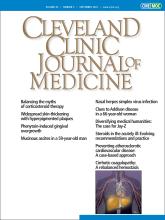A 27-year-old man presented to our neurosurgery clinic with a 3-month history of lower-extremity weakness and slurred speech.
After a traffic accident 1 year earlier, he had undergone right decompressive hemicraniectomy to evacuate an acute subdural hematoma, and after an episode of posttraumatic seizure associated with the hemicraniectomy, he was prescribed phenytoin for seizure prophylaxis and has been taking it ever since.
The patient had no past history of significant neuro logic abnormalities. On examination, a Medical Research Council grade of 4/5 was noted bilaterally in his lower limbs. Nerve conduction studies showed increased latency and decreased conduction velocity in major nerves of the lower limbs. No other abnormalities were noted relative to gait, reflexes, or autonomic function, and he had no nystagmus or confusion.
Intraoral examination revealed generalized puffy, lobulated, swollen gums in the upper and lower jaws. The gingival swelling covered more than one-third of the tooth crown in the upper row and more than two-thirds in the lower row (Figure 1). The gingival lesions did not bleed on probing but were tender and suppurative at some places. In addition to gingival overgrowth, there was hypertrichosis over the upper and lower extremities.
Pinkish overgrowths of the gingiva covering the tooth crowns.
Given the patient’s history of phenytoin use and the known association of phenytoin with gingival overgrowth, his serum concentration of phenytoin was measured and was found to be greater than 40 μg/mL (reference range 10–20). Phenytoin-induced peripheral neuropathy and gingival overgrowth were diagnosed, and his antiseizure medication was changed to carbamazepine. After 2 months, the gingival growth had regressed significantly (Figure 2). Further, there was improved strength in the patient’s lower extremities, and the hair growth over his arms and legs had lessened. We referred him to our periodontal department for further management.
Follow-up examination showing regression of gingival growth.
GINGIVAL ENLARGEMENT
Inflammatory gingival enlargement is a risk in several clinical settings. It can occur after long-standing gingivitis secondary to local irritants such as dental plaque and calculus, as a complication of fractured teeth or ill-fitting dentures, and as a consequence of mouth-breathing.1 Hereditary conditions such as gingival fibromatosis, Zimmermann-Laband syndrome, Rutherford syndrome, Ramon syndrome, and some lysosomal storage diseases can also cause gingival enlargement.2,3 Systemic conditions associated with generalized gingival enlargement include leukemia, granulomatosis with polyangiitis, sarcoidosis, and tuberculosis.
Drug-induced gingival overgrowth also causes diffuse gingival enlargement. In most cases, the diagnosis can be made on the basis of the history, physical examination, laboratory investigation, and histopathologic testing, as well as associated systemic features present in many of these conditions.
A drug side effect
Drug-induced gingival overgrowth is a notable side effect of anticonvulsant drugs (phenytoin, vigabatrin, ethosuximide, topiramate, lamotrigine, valproate, phenobarbital), immunosuppressants (cyclosporine, tacrolimus, sirolimus), and calcium channel blockers (nifedipine, felodipine, verapamil, diltiazem).4 Phenytoin is the most common culprit, and gingival enlargement is reported in up to 50% of patients who take the drug.5 It has a direct action on high-activity gingival fibroblasts, and the related severity of gingi-val enlargement is dose-dependent.6
Drug-induced gingival overgrowth usually presents as enlargement of gingival tissue that encroaches on the tooth crowns. Secondary inflammation of these lesions leads to gum bleeding and discomfort with chewing or toothbrushing. It is diagnosed clinically when a patient has gingival enlargement, is taking a medication from one of the causative classes, and has no intraoral or general physical examination features that suggest an inflammatory, hereditary, or systemic condition.
Discontinuing the offending drug coupled with meticulous oral hygiene may lead to resolution, but surgical intervention to the gingiva is usually required.6 Seizure prophylaxis is not indicated in all cases of posttraumatic seizure. However, because our patient had a history of late posttraumatic seizure, we changed his medication from phenytoin to carbamazepine, a safer alternative, rather than stop his anti-seizure treatment.
Phenytoin treatment: Educate and monitor
Phenytoin is commonly used for prophylaxis and treatment of epilepsy. Clinicians who prescribe it are advised to educate their patients regarding the adverse effects of phenytoin-like drugs and to monitor patients at consistent intervals. Dental referral is advisable for patients who are taking phenytoin and develop gingival hypertrophy, not only for proper management of the condition but also to enhance motivation to maintain proper oral hygiene.
DISCLOSURES
The authors report no relevant financial relationships which, in the context of their contributions, could be perceived as a potential conflict of interest.
- Copyright © 2022 The Cleveland Clinic Foundation. All Rights Reserved.








